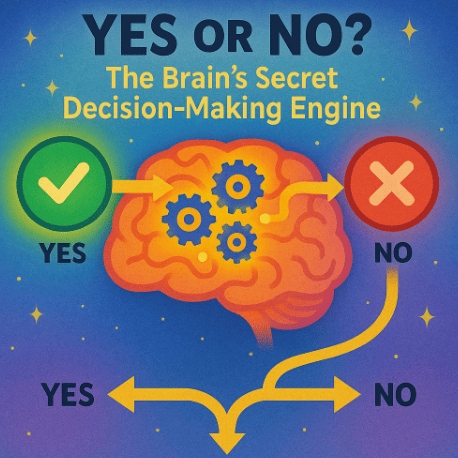
In Lesson 1, we discovered how sparks between neurons grow into thoughts. In Lesson 2, we learned how the brain solves problems using its toolbox: trial and error, memory, logic, creativity, and heuristics (shortcuts).
Now, we face the next big question: how does the brain decide? After all, once you have thoughts and problem-solving tools, you still need to choose: “Do I do this… or that?”
What Is a Decision? 🤔
A decision is simply choosing between options.
-
Should I eat pizza or pasta?
-
Should I do my homework now or later?
-
Should I say yes to this job or no?
Every decision, big or small, means your brain is comparing possibilities and picking one path forward.
But how does the brain do this comparing? Let’s peek inside the decision-making engine.
The Brain’s Weighing Scale ⚖️
Think of the brain like a weighing scale. On one side, you put the possible rewards (what you gain). On the other side, you put the possible risks (what you lose).
Example:
-
Eating ice cream now (reward = yummy taste).
-
But maybe getting a stomachache later (risk).
Your brain compares both sides. If the reward feels bigger, you say “yes.” If the risk feels bigger, you say “no.”
The part of the brain that does this weighing is the prefrontal cortex (right behind your forehead). It’s the master planner and the logical judge.
The Emotional Push and Pull ❤️🔥
But logic is not alone. Your limbic system—the emotional brain—jumps into the game.
-
The amygdala (almond-shaped part deep in the brain) warns about dangers and makes you feel fear.
-
The nucleus accumbens lights up with excitement when you imagine rewards, like winning a prize.
So decision-making is a tug-of-war between emotion and logic. Sometimes logic wins, sometimes emotions pull harder.
Example: You know logically you should study for your test. But the emotional part says, “The new video game is so fun!” If emotions win, you play instead of studying.
Fast vs. Slow Decisions ⏱️
Not all decisions are made the same way. Psychologists call this System 1 vs. System 2 thinking.
-
System 1 = Fast, Automatic.
Quick, emotional, gut-feeling choices. Example: Jumping back when a car honks suddenly. -
System 2 = Slow, Careful.
Logical, step-by-step choices. Example: Deciding which college to attend.
Both systems are important. If you used only fast decisions, you’d make reckless mistakes. If you used only slow decisions, you’d waste time on tiny choices (like which socks to wear). The brain balances both.
Habit and Decision: The Autopilot Switch 🛫
Remember habits from earlier? Habits take away the need for decisions. When something is automatic, your brain doesn’t weigh options anymore.
For example: You don’t decide how to brush your teeth each morning—you just do it. The basal ganglia (a deep brain area) handles habits, freeing the prefrontal cortex for more important decisions.
This is why too many choices in a day can make you feel decision fatigue. Your brain gets tired of weighing things, and you fall back on habits.
The Role of Dopamine: The Brain’s Yes Chemical 🧪
Inside your brain, a chemical called dopamine plays a huge role in decisions. Dopamine is a neurotransmitter that signals reward and motivation.
When you imagine something exciting—like winning a game—dopamine levels rise. This makes you more likely to choose the option that promises reward.
This is why gambling or video games can be addictive: the brain keeps chasing the dopamine rush.
When Decisions Go Wrong ⚠️
Sometimes the brain’s decision-making system doesn’t work properly:
-
If the amygdala is too active → people feel anxious and avoid even safe choices.
-
If the reward system is too strong → people may take risky bets or addictions.
-
If the prefrontal cortex is weak (like in young kids) → logic struggles to control emotions.
That’s why children often make impulsive choices—they are still developing their prefrontal cortex. Adults usually have stronger logic filters, though emotions can still win at times.
Conclusion 🌟
So how does the brain decide “yes or no”?
-
The prefrontal cortex weighs risks and rewards.
-
The limbic system adds emotions.
-
System 1 (fast) and System 2 (slow) handle different kinds of choices.
-
Habits remove the need for some decisions.
-
Dopamine pushes the brain toward rewards.
Decision-making is like having a election inside your head, with logic, emotion, habit, and chemicals all casting their votes.
Sometimes the decision is smart. Sometimes it’s risky.
But together, they make you who you are.